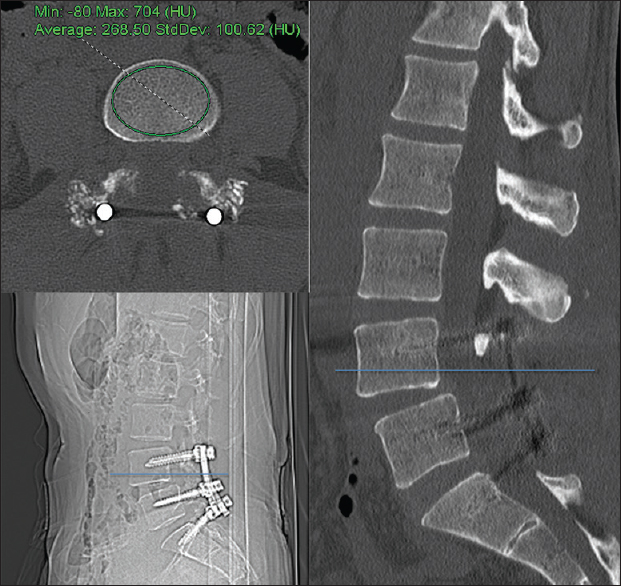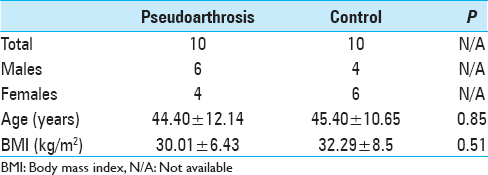- Department of Neurosurgery, Medical College of Wisconsin, Milwaukee, Wisconsin, USA
Correspondence Address:
Ha Son Nguyen
Department of Neurosurgery, Medical College of Wisconsin, Milwaukee, Wisconsin, USA
DOI:10.4103/2152-7806.170443
Copyright: © 2015 Surgical Neurology International This is an open access article distributed under the terms of the Creative Commons Attribution-NonCommercial-ShareAlike 3.0 License, which allows others to remix, tweak, and build upon the work non-commercially, as long as the author is credited and the new creations are licensed under the identical terms.How to cite this article: Nguyen HS, Shabani S, Patel M, Maiman D. Posterolateral lumbar fusion: Relationship between computed tomography Hounsfield units and symptomatic pseudoarthrosis. Surg Neurol Int 25-Nov-2015;6:
How to cite this URL: Nguyen HS, Shabani S, Patel M, Maiman D. Posterolateral lumbar fusion: Relationship between computed tomography Hounsfield units and symptomatic pseudoarthrosis. Surg Neurol Int 25-Nov-2015;6:. Available from: http://surgicalneurologyint.com/surgicalint_articles/posterolateral-lumbar-fusion-relationship-between-computed/
Abstract
Background:Assessment of bone quality can guide spinal surgery. However, surgeons infrequently evaluate bone quality in a quantitative manner. Recent literature suggests a role for computed tomography (CT) Hounsfield units (HUs) as a marker for bone quality. Limited data exist regarding its utility with respect to posterolateral lumbar fusion (PLF).
Methods:From fall 2010 to winter 2012, 10 patients underwent revision surgery for symptomatic pseudoarthrosis (defined as intractable pain associated with either radiographic evidence of nonunion or intraoperative evidence of nonunion) after a prior L4–S1 PLF. These patients were age-matched (±5 years) to 10 patients who underwent L4–S1 PLF with no clinical signs of pseudoarthrosis at 1-year follow-up. Available CT imaging (with or without instrumentation) was evaluated from L1 to L5 for the averaged HU. Data were pooled among L1–L3 values and between L4 and L5 values.
Results:Within the pseudoarthrosis group, the pooled L1–L3 HU value was similar to the pooled L4–L5 HU value (168.39 ± 22.84 HU vs. 166.98 ± 23.20 HU respectively, P = 0.89). The same pattern was observed for the control group (190.24 ± 37.13 HU vs. 201.89 ± 36.59 HU respectively, P = 0.44). On the other hand, the pooled L1–L3 and L4–L5 HU values were larger for the control group compared to the pseudoarthrosis group, with the pooled L4–L5 HU demonstrating statistical significance, P = 0.01.
Conclusion:Currently, CT imaging is typically not obtained prior to lumbar fusion. Results demonstrated that CT HU values were significantly larger for patients who did not exhibit symptomatic pseudoarthrosis at 1-year follow-up compared to those who required revision surgery. As such, CT HU values may serve as a predictor for bony fusion to guide surgical management of patients under consideration for PLF.
Keywords: Computed tomography, Hounsfield units, lumbar fusion, pseudoarthrosis
INTRODUCTION
The incidence of pseudoarthrosis after posterolateral lumbar fusion (PLF) can be as high as 20%.[
METHODS
The approval of the institutional board review at our hospital was obtained prior to the study.
Patients who underwent PLF (L4–S1) were retrospectively evaluated between fall 2010 to winter 2012. Ten patients exhibited symptomatic pseudoarthrosis (defined as intractable pain associated with either radiographic evidence of nonunion or intraoperative evidence of nonunion) and underwent revision surgery. These patients were age-matched (±5 years) to 10 patients who exhibited no clinical signs of pseudoarthrosis at 1 year follow-up. To be under consideration for the study, patients had to have CT imaging of the lumbar spine (within approximately 1 year of initial operation and/or revision) available for review. This criterion limited the patient population because CT imaging was seldom obtained prior to lumbar fusion. Patient clinical data (age, gender, body mass index [BMI], and extent of follow-up) were collected via chart review.
Available CT imaging (with or without instrumentation) was evaluated at the axial plane (cranial to the inferior endplate) from L1 to L5. This location has been employed in prior studies,[
Statistical analysis was performed with IBM SPSS 22 (Chicago, IL, USA). Interobserver and intraobserver reliability calculations were performed with the use of the interclass correlation coefficient (where 0 represents no agreement and 1 represents perfect agreement). A value >0.8 was considered an indication of excellent agreement. Student's t-test (two-tailed) was performed to compare for statistical significance between the control group and the pseudoarthrosis group.
RESULTS
The pseudoarthrosis group and the control group each had 10 patients. Age remained comparable since the patients were age-matched for the study; BMIs were also comparable.
Within the pseudoarthrosis group, the pooled L1–L3 HU value was similar to the pooled L4–L5 HU value; the same pattern was observed for the control group. On the other hand, the pooled L1–L3 and L4–L5 HU values were larger for the control group compared to the pseudoarthrosis group, where the comparison between pooled L4–L5 HU values demonstrated statistical significance, P = 0.01.
DISCUSSION
Poor bone quality has been associated with pseudoarthrosis and instrumentation failure.[
Presumably, CT HU values may help guide successful spinal fusion. Limited literature exists regarding this topic. In 2014, Schreiber et al.[
Our study demonstrated that CT HU values were significantly larger for patients who did not exhibit symptomatic pseudoarthrosis at 1 year follow-up compared to those who underwent revision surgery. The results suggest that the parameter may be a useful adjunct to assess bone health and to guide surgical management for those patients considered for PLF. This complements the conclusions obtained by Schreiber et al. regarding lumbar interbody fusion. A few differences are noted. This study assessed symptomatic pseudoarthrosis while Schreiber et al. emphasized radiographic nonunion. Moreover, their measure of global bone density (HU values at rostal vertebral bodies) was equivalent to our L1-L3 pooled HU values; however, their values were lower compared to our values; this can be explained by an older patient population in their study. HU values diminish relatively linearly with each additional decade, ranging from an average 255.1 HU in the second decade of life to an average 78.7 HU in the ninth decade of life.[
CT imaging was seldom obtained for surgical management; available CT imaging was predominantly obtained for other medical concerns. This aspect limited the number of patients for the study. The decision to age-match the control group appeared valid given the small patient pool and the impact of age on CT HU values and bone mineral density. Unlike other prior studies,[
CONCLUSION
Currently, CT imaging is typically not obtained prior to lumbar fusion. Results demonstrated that CT HU values were significantly larger for patients who did not exhibit symptomatic pseudoarthrosis at 1 year follow-up compared to those who required revision surgery. As such, CT HU values may serve as a predictor for bony fusion to guide surgical management of patients under consideration for PLF.
Financial support and sponsorship
Nil.
Conflicts of interest
There are no conflicts of interest.
References
1. DeWald CJ, Stanley T. Instrumentation-related complications of multilevel fusions for adult spinal deformity patients over age 65: Surgical considerations and treatment options in patients with poor bone quality. Spine (Phila Pa 1976). 2006. 31: S144-51
2. Dimar JR, Glassman SD, Burkus JK, Pryor PW, Hardacker JW, Carreon LY. Clinical and radiographic analysis of an optimized rhBMP-2 formulation as an autograft replacement in posterolateral lumbar spine arthrodesis. J Bone Joint Surg Am. 2009. 91: 1377-86
3. Dipaola CP, Bible JE, Biswas D, Dipaola M, Grauer JN, Rechtine GR. Survey of spine surgeons on attitudes regarding osteoporosis and osteomalacia screening and treatment for fractures, fusion surgery, and pseudoarthrosis. Spine J. 2009. 9: 537-44
4. Galimberti F, Lubelski D, Healy AT, Wang T, Abdullah KG, Nowacki AS. A systematic review of lumbar fusion rates with and without the use of rhBMP-2. Spine (Phila Pa 1976). 2015. 40: 1132-9
5. Glassman SD, Anagnost SC, Parker A, Burke D, Johnson JR, Dimar JR. The effect of cigarette smoking and smoking cessation on spinal fusion. Spine (Phila Pa 1976). 2000. 25: 2608-15
6. Groff MW, Dailey AT, Ghogawala Z, Resnick DK, Watters WC, Mummaneni PV. Guideline update for the performance of fusion procedures for degenerative disease of the lumbar spine. Part 12: Pedicle screw fixation as an adjunct to posterolateral fusion. J Neurosurg Spine. 2014. 21: 75-8
7. Lee CS, Chung SS, Choi SW, Yu JW, Sohn MS. Critical length of fusion requiring additional fixation to prevent nonunion of the lumbosacral junction. Spine (Phila Pa 1976). 2010. 35: E206-11
8. Meredith DS, Schreiber JJ, Taher F, Cammisa FP, Girardi FP. Lower preoperative hounsfield unit measurements are associated with adjacent segment fracture after spinal fusion. Spine (Phila Pa 1976). 2013. 38: 415-8
9. Schreiber JJ, Anderson PA, Rosas HG, Buchholz AL, Au AG. Hounsfield units for assessing bone mineral density and strength: A tool for osteoporosis management. J Bone Joint Surg Am. 2011. 93: 1057-63
10. Schreiber JJ, Hughes AP, Taher F, Girardi FP. An association can be found between hounsfield units and success of lumbar spine fusion. HSS J. 2014. 10: 25-9
11. Takahashi S, Suzuki A, Toyoda H, Terai H, Dohzono S, Yamada K. Characteristics of diabetes associated with poor improvements in clinical outcomes after lumbar spine surgery. Spine (Phila Pa 1976). 2013. 38: 516-22








